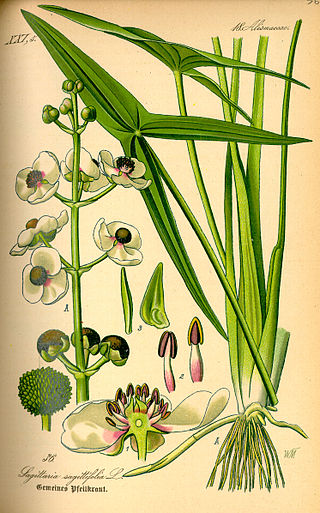
Sagittaria is a genus of about 30 species of aquatic plants whose members go by a variety of common names, including arrowhead, duck potato, swamp potato, tule potato, and wapato. Most are native to South, Central, and North America, but there are also some from Europe, Africa, and Asia.

Sagittaria sagittifolia is an Old World flowering plant in the family Alismataceae.

Sagittaria montevidensis is a species of flowering plant in the water-plantain family Alismataceae. Common names include giant arrowhead and California arrowhead.
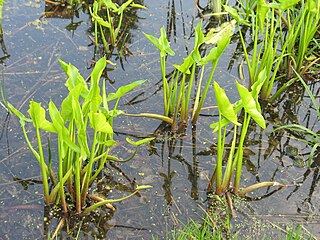
Peltandra virginica is a plant of the arum family known as green arrow arum and tuckahoe. It is widely distributed in wetlands in the eastern United States, as well as in Quebec, Ontario, and Cuba. It is common in central Florida including the Everglades and along the Gulf Coast. Its rhizomes are tolerant to low oxygen levels found in wetland soils. It can be found elsewhere in North America as an introduced species and often an invasive plant.

Sagittaria lancifolia, the bulltongue arrowhead, is a New World perennial, monocot plant in the family Alismataceae, genus Sagittaria, with herbaceous growth patterns.
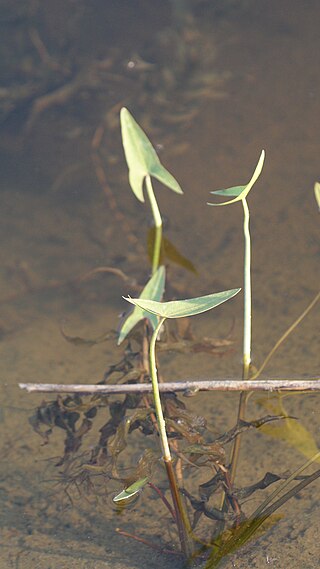
Sagittaria cuneata is a North American species of flowering plant in the water plantain family known by the common name arumleaf arrowhead or duck potato. Like some other Sagittaria species, it may be called wapato.

Sagittaria longiloba is a North American species of flowering plant in the water plantain family known by the common name longbarb arrowhead and Gregg arrowhead.

Sagittaria sanfordii is an uncommon species of flowering plant in the water plantain family known by the common names valley arrowhead and Sanford's arrowhead that is endemic to California.

Sagittaria australis, the Appalachian arrowhead or longbeak arrowhead, is a plant found in North America. It is a perennial herb up to 130 centimetres tall. It is an unusual Sagittaria species in that it has a five-winged petiole. The flowers are up to 3 cm (1 in) in diameter, white, producing an achene with a recurved beak.

Sagittaria papillosa, the nipplebract arrowhead, is a perennial plant species growing up to 120 centimetres tall. Petioles are triangular in cross-section, the leaf blade very narrowly elliptical to ovate, not lobed. The species is distinguished from others in the genus by having bumps (papillae) resembling nipples on the flower bracts.

Sagittaria isoetiformis, common name quillwort arrowhead, is an aquatic plant species. It is similar to Sagittaria tenuis and often mistaken for it, but S. isoetiformis has flattened leaves rather than leaves round in cross-section. Leaves of both species are usually submerged but sometimes emerging from the water.

Sagittaria rigida, the sessilefruit arrowhead or Canadian arrowhead, is an aquatic plant species. It has narrow oval leaves rather than the iconic arrowhead shaped leaves of species like the Sagittaria latifolia. it has sessile female flowers, from whence its name comes. Its flowers are very similar to other plants in the Sagittaria family, with three white petals.
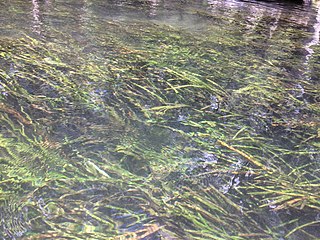
Sagittaria kurziana, common names springtape and strap-leaf sagittaria, is a perennial aquatic plant. It grows up to 250 centimetres tall. It has long, narrow, flat leaves that float on the surface of the water, up to 250 cm long but rarely more than 15 millimetres wide. These form huge masses of ribbon-like leaves flowing back and forth with the current. Inflorescences also float on the surface, the white flowers very often submerged.

Sagittaria teres, the quill-leaved arrowhead or slender arrowhead, is an aquatic plant species in the genus Sagittaria. It is a perennial herb up to 80 centimetres tall. The leaves can grow both under and above the water. The flowers are white, up to 1.5 cm in diameter, borne in one or more whorls on a stalk rising above the leaves.

Sagittaria ambigua, the Kansas arrowhead, is an aquatic plant species native to North America. It is a perennial herb growing up to 90 centimetres tall. The leaves are broadly lanceolate, the blade up to 20 cm (8 in) long and 12 cm wide.
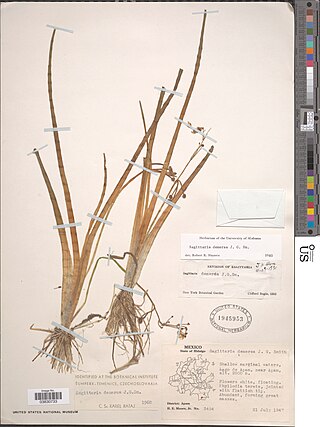
Sagittaria demersa, commonly called Chihuahuan arrowhead, is an annual aquatic plant growing up to 60 centimetres tall. The leaves are flat, very long and narrow, up to 55 cm (22 in) long but rarely more than 7 millimetres across.

Sagittaria filiformis, the threadleaf arrowhead, is a perennial aquatic plant growing up to 170 centimetres tall. Some leaves are thread-like, entirely underwater, but others are narrowly ovate or lanceolate and floating on the surface.

Sagittaria engelmanniana is a perennial aquatic plant growing up to 70 centimetres tall. The leaves are sagittate (arrow-shaped) with 3 very narrow lobes.

Sagittaria graminea, the grassy arrowhead or grass-leaved arrowhead, is an aquatic plant species native to eastern North America.

Sagittaria subulata, the awl-leaf arrowhead, narrow-leaved arrowhead or dwarf sagittaria, is an aquatic plant species.




















